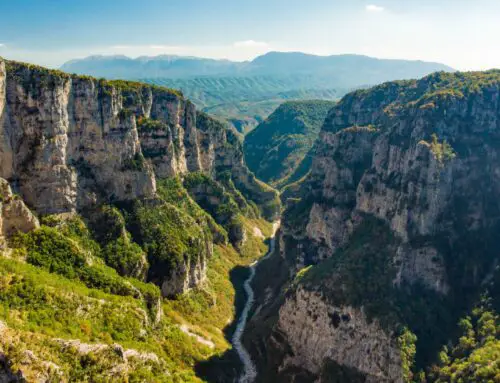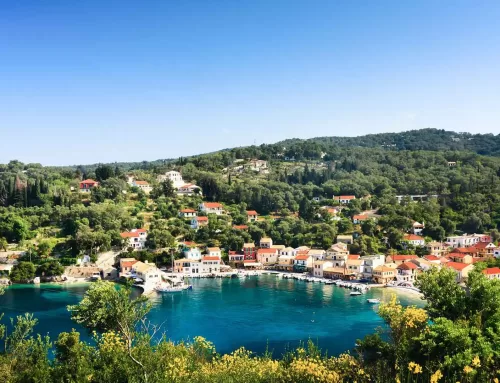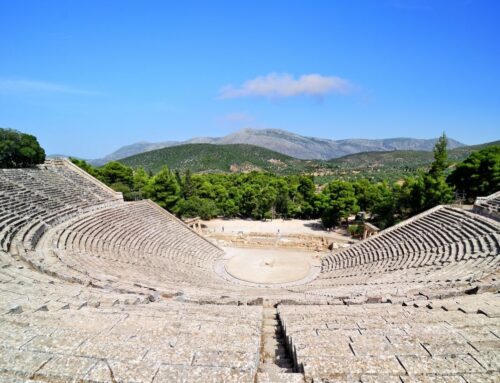
20 Impressive Landmarks In Greece You Have To See
20 Impressive Landmarks In Greece You Have To See

☞ Table of Contents:
Spanning from north to south, from the mainland to the islands, these are the landmarks in Greece that have become known worldwide. They are a symbol of the country, its history and its unshakable status as a dream holiday destination!
The Parthenon
Sitting atop a rocky outcrop in the capital is one of the most important landmarks in Greece, the Parthenon. The Parthenon is a defining feature of Athens and the Acropolis has a long history, having once fortified the city in ancient times. Constructed in 432 BC, today it stands to be one of the most recognisable features of Greece and is a must-do in Athens for every visitor.
☞ Related: Is The Agora In Athens Better Than The Acropolis?
The Acropolis Museum
Opened in 2009, this museum is one of the best in the city. The Acropolis Museum has won awards for both its architecture and conservation. Held up by colossal concrete columns, the modern architecture mirrors that of the Parthenon. Light floods the floor to ceiling windows, bathing the ancient relics in a golden glow. When you visit you will see why this museum and the building is a defining landmark in Greece.
☞ Related: What Are The Elgin Marbles And Why Are They So Famous
View our FREE master guide for Athens here!
It includes an interactive map!
The Panathenaic Stadium
Right in the heart of the city of Athens lies the worlds only stadium made entirely out of marble. Kallimarmaro, as it is called in Greek, or the Panathenaic stadium is one of the most impressive landmarks in Greece. In ancient times it was used for hosting the renowned Panathenaic Games, to honour the goddess Athena. More recently, the Panathenaic Stadium hosted the first modern Olympic Games in 1896.
☞ Related: The Ancient Olympic Events You Need To Know About
The Academy Of Athens
In ancient times the Academy was a school founded by the Greek philosopher Plato. It was a place where the great thinkers of the time came to have discussions about anything from philosophy to astronomy. Today the Academy of Athens is one of the most important landmarks in Athens. Established in 1926, it is involved in supporting the advancement of the sciences, fine art and the humanities, its name giving reference to Plato’s once flourishing organisation.
☞ Related: The Greek Female Philosophers You Really Should Not Ignore
Theatre of Epidaurus
The Theatre of Epidaurus is one of the most well preserved in Greece. In ancient times theatre was an integral part of society and Greece produced some of the most prominent playwrights in history. This magnificent theatre is located at the Sanctuary of Asklepios, the Greek god of medicine, in the Peloponnese. This landmark in Greece is a symbol of this long appreciation of the arts, which is still enjoyed today.
☞ Related: The Top Ancient Greek History Facts For A Greek History Noob

The Sanctuary Of Apollo
Nestled in the foothills of Mount Parnassus and overlooking valleys carpeted with olive trees lies the Sanctuary of Apollo. Arguably one of the most important ancient sites in the country it is no wonder this place has become a landmark in Greece. Delphi was home to the Pythia, or oracle, who was able to channel the god, Apollo. It was here, at the Sanctuary of Apollo, that people would travel from far and wide to hear her prophecies.
☞ Related: 6 Of The Most Important Ancient Greek Cities
The Corinth Canal
The Corinth canal is an extraordinary feat of modern-day engineering. The canal connects the Ionian Sea and Saronic Gulf. If you cross the man-made landmark in Greece, you will gain a bird’s eye view of the structure that has transformed the former Peloponnese peninsula into yet another amazing Greek ‘island’.
Olympia
Olympia has become a landmark in Greece as it is the birthplace of the ancient Olympics. The first Olympic events date back to 776 BC and were held at the very ancient Greek site in Olympia that you can visit today. Competitors came from far and wide, from all over Greece to compete in the games.

Lion Gates Of Mycenae
Mycenae was once the capital of a military power that dominated a large part of Greece. Located in the Peloponnese, it was an important cultural centre influencing the wider Mediterranean region. Because it was such a crucial stronghold, today the remains of this civilisation remain an important landmark in Greece. The Lion Gate in Mycenae marks the entrance to this ancient citadel.
Alexander The Great
Alexander the Great or Alexander the III of Macedon was the Macedonian king that ruled in Greece from 336 to 323 BC. Tutored by Aristotle, he went on to conquer much of the ancient world. His empire spanned from Macedonia to Egypt and even as far as India! His statue on the waterfront in Thessaloniki is a grand landmark in Greece that pays homage to his reign.
☞ Related: 5 Famous Monuments Of Northern Greece That Will Steal Your Heart
View our FREE master guide for Thessaloniki here!
It includes an interactive map!
The White Tower
The White Tower of Thessaloniki was once part of a Byzantine fortress. Today it is one of the most significant monuments of the city and the balcony offers panoramic views of the waterfront. The White Tower, while being a landmark in Northern Greece, is also an important museum in Thessaloniki. Each floor presents an aspect of the city’s everyday life. By visiting all the floors, you will get a full presentation of the city’s history from 316 BC to modern-day!
Meteora
Meteora is one of the most unique landmarks in Greece, and due to its historical importance is included on the UNESCO World Heritage List. Built in the 14th century, hermit monks inhabited these monasteries perched high on towering rock for hundreds of years. Their precarious position helped actively discourage visitors and conquerors, allowing the hermits to freely spend their days in pursuit of salvation.
☞ Related: 10 Incredible Ancient Greek Sites To Add To Your Bucket List
The Stone Houses Of Zagori
The stone houses of Zagori are a landmark in Greece that will call to you if you are an explorer who likes to wander off the beaten track. Located in Northern Greece, this region consists of 46 villages, each with characteristic traditional stone houses and cobbled alleys. The appealing nature of this picturesque cluster of villages draws people from the big cities to enjoy a quiet mountainous escape.
☞ Related: The Most Enchanting Villages in Mainland Greece You Need To Visit
Vikos Gorge
There are many incredible national parks in Greece but none have a landmark like that of Vikos–Aoös National Park in Epirus. This national park is home to the deepest gorge in the world, Vikos Gorge. A visit to this landmark is a must if you are in this region as the deep chasm that cuts through this valley is truly a geographical marvel!
Mount Olympus
Home of the Greek gods, the distinctive mountain is the highest in Greece. The extensive views, steep stony outcrops and intriguing mythology make this landmark in Greece one of intense beauty. Mount Olympus sparks the curiosity of hikers and nature lovers who end up exploring its many trails and peaks.
☞ Related: What Is It Like Climbing The Tallest Mountain In Greece?
The Blue Domes Of Santorini
You most likely have Santorini on your list for a Greek holiday and we can’t blame you! It is one of the most well-known islands in the world. One of the reasons being it’s unique and brightly coloured Cycladic architecture. The blue rooftops are so loved they are now a landmark in Greece that many identify with. It is unlikely that you would find someone that did not recognise these rooftops as belonging to Santorini!

Windmills Of Mykonos
Like the blue domes of Santorini, the popular Cycladic island of Mykonos has its own feature that many people classify as being distinctly Mykonian. Built originally by the Venetians to mill wheat in the 16th century, the windmills of Mykonos are now a significant landmark in Greece and a symbol of this vibrant island. Though purely aesthetic they are a prominent reminder of the island’s beauty and history.
☞ Related: How To Explore Mykonos In 3 Days
Palace Of Knossos
With its vibrant colours and fascinating history, the Palace of Knossos on the Greek island of Crete is another important landmark in Greece. According to mythology the Palace once belonged to King Minos. As legend has it a monster, half man and half bull was kept beneath the palace in a complex labyrinth that prevented the Minotaur from escaping.
☞ Related: Famous Greek Islands You’ll Know From Mythology
Elafonisi Beach
With vibrant crystal clear water and soft white sand with pink hues, Elafonisi beach in Crete is frequently rated amongst the best in the world. This beach has become a landmark in Greece due to its profound natural beauty.
☞ Related: 7 Greek Beaches You Definitely Need To Put On Your Bucket List
Temple Of Apollo In Naxos
This great solitary arch is an instantly recognisable landmark in Greece. The lone arch is all that remains of the Temple of Apollo on the island of Naxos in the Cyclades. Every visitor takes time to see the sunset over the Aegean, framed beautifully by this ancient treasure.
☞ Related: The 10 Best Things To Do In Naxos
For a personalized consultation tailored to your preferences and interests, feel free to reach out to us.
Use the link below to book a free consultation.
*Disclaimer: This page might include affiliate links. If you decide to book something through one of them, I might get a little bonus, but it won't cost you anything extra.*





























